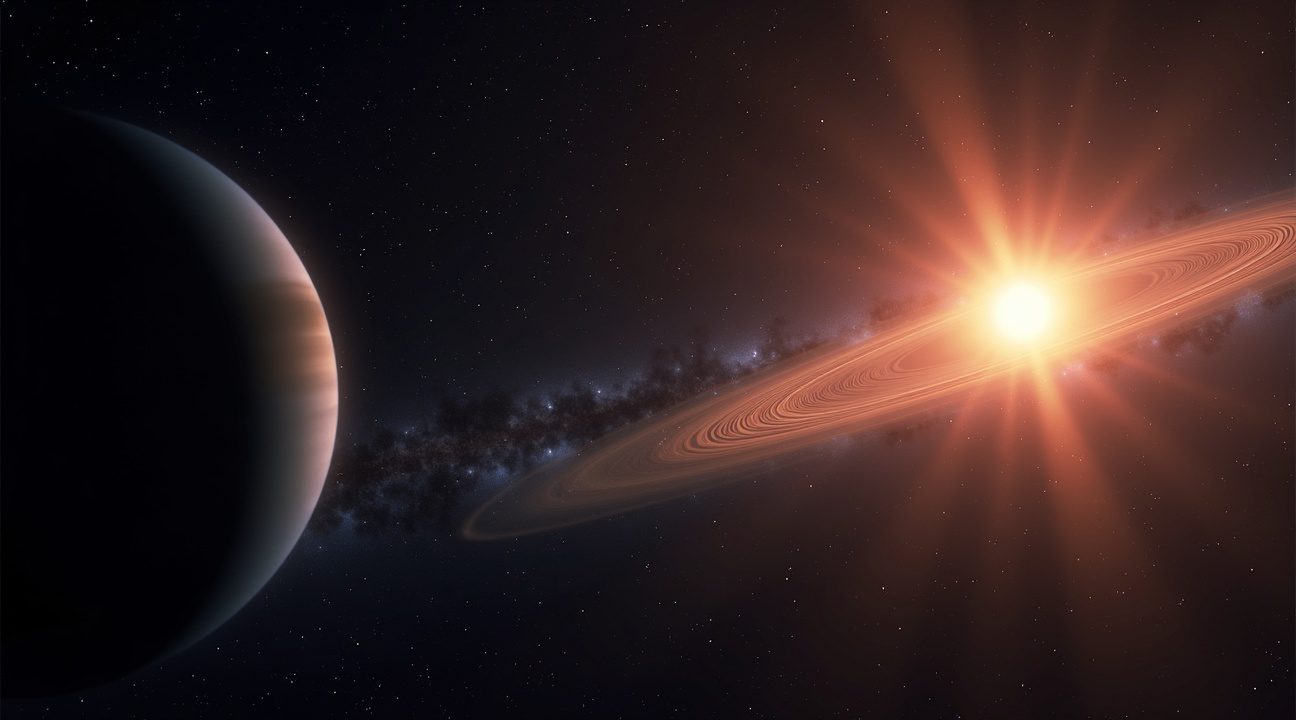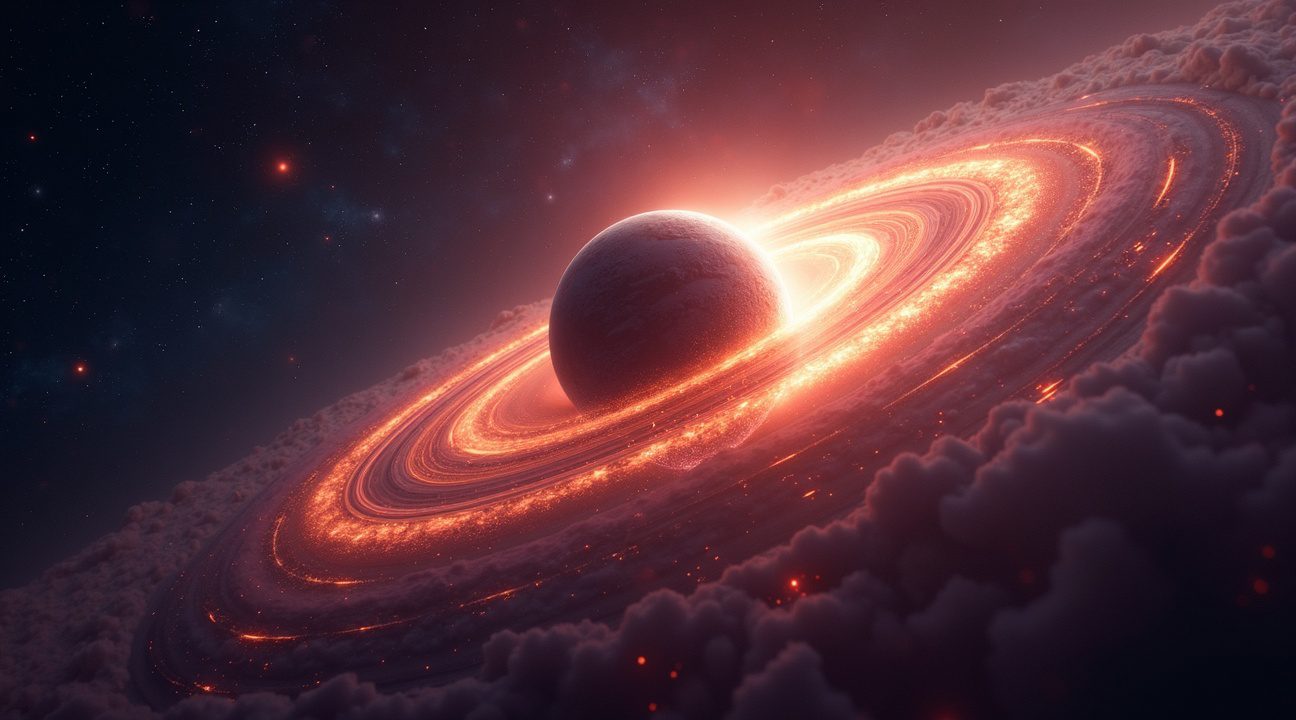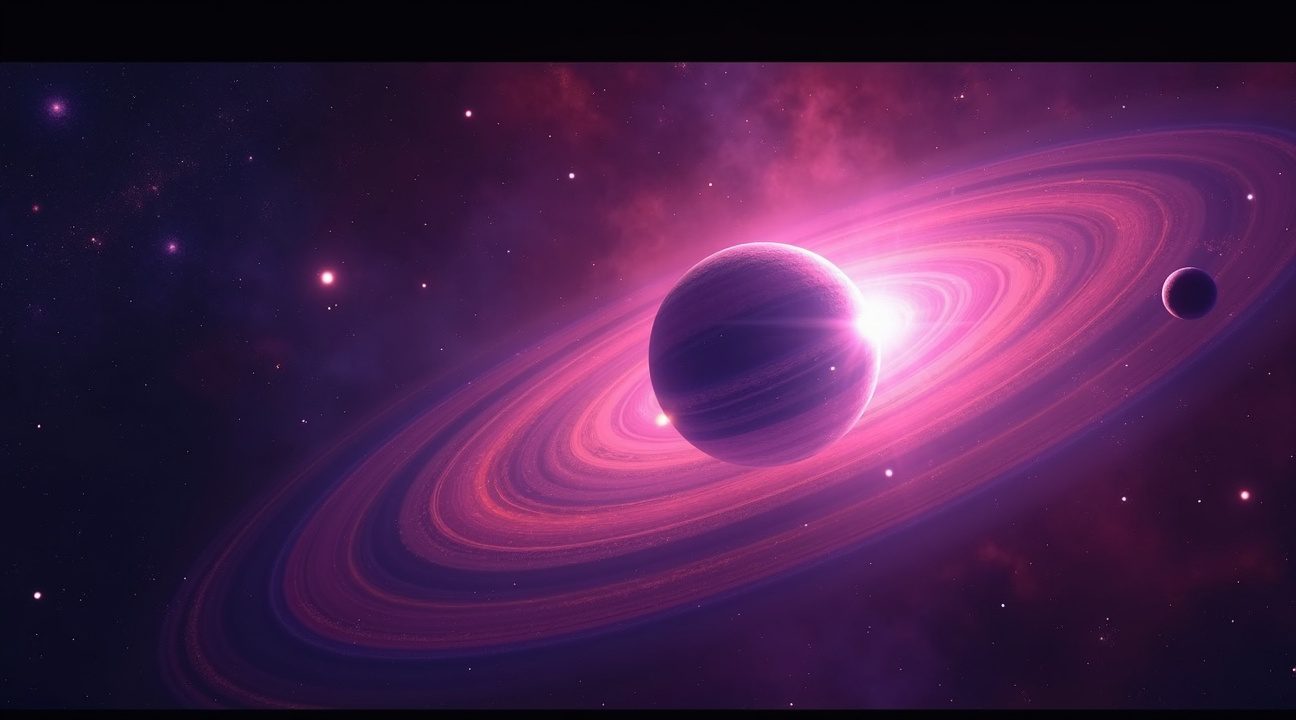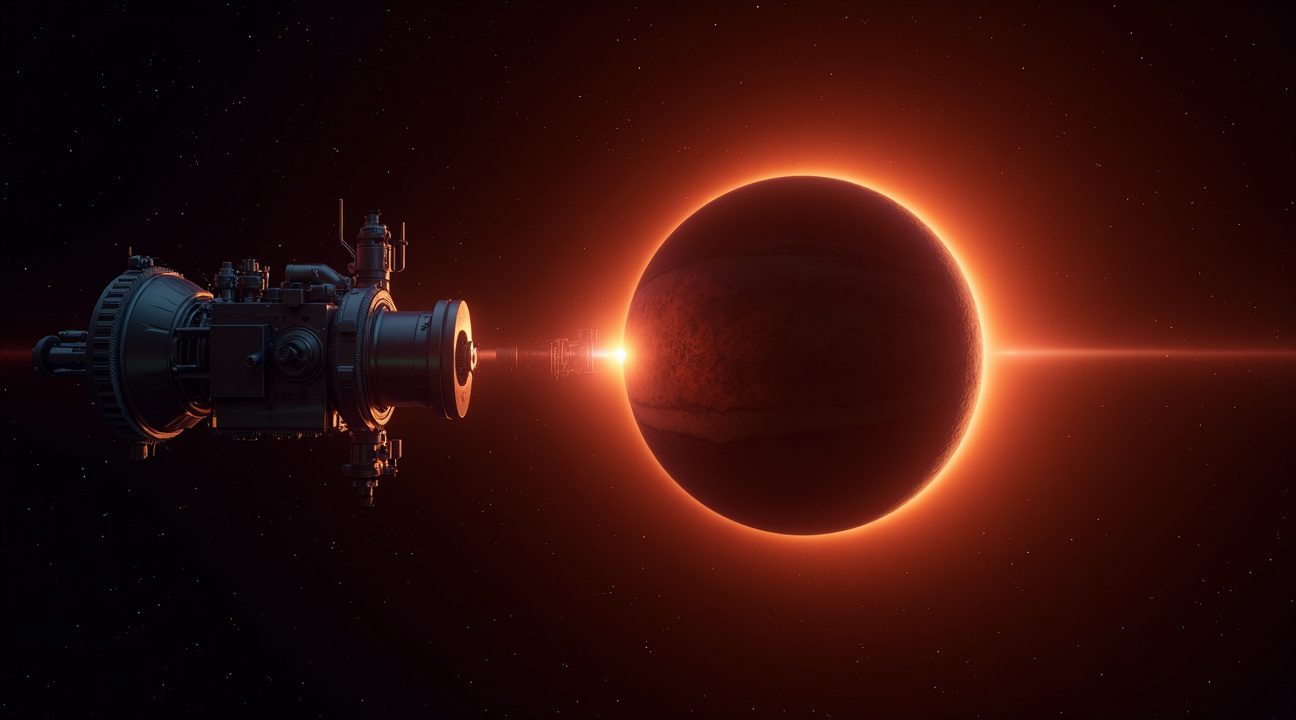The James Webb Space Telescope (JWST) has made unprecedented strides in the direct imaging of exoplanets, capturing stunning details of distant worlds and igniting debates about the possibility of alien life due to unexplained luminous phenomena discovered in outer space.
Breakthrough Observations by the James Webb Space Telescope
With its revolutionary coronagraph technology and extreme sensitivity, JWST has redefined how scientists view planetary systems beyond our own. These advancements have allowed the telescope to image some of the lightest and most elusive exoplanets to date, providing insights that were previously impossible with older instruments.
Key Takeaways
- Direct Imaging of TWA 7 b: JWST directly imaged TWA 7 b, the lightest exoplanet ever captured through this method, weighing ten times less than any previously detected and residing within a defined debris disk.
- Disappearing Planet at Alpha Centauri A: A mysterious planet candidate observed near Alpha Centauri A was not seen in subsequent observations, giving rise to theories of a “disappearing planet” due to eccentric orbital behavior revealed by simulations.
- Accreting Rogue Planet: JWST observed a rogue planet devouring matter at six billion tonnes per second—marking the most extreme accretion event for a planetary-mass object on record and questioning established planetary formation theories.
- Moon-Forming Disk Discovered: The telescope achieved the first direct measurement of a moon-forming disk surrounding exoplanet CT Cha b, uncovering carbon-rich materials essential for satellite creation around distant gas giants.
- Advanced Coronagraph Capabilities: Thanks to cutting-edge coronagraph technology, JWST can now detect planets ten times lighter than previously possible. This revolutionizes the field, moving from basic planet detection to in-depth atmospheric and compositional analysis.
These achievements not only strengthen JWST’s role in current astronomical research but also point to a new era in which the mysteries of alien worlds are no longer beyond our grasp. Stay updated by visiting NASA’s official JWST exoplanet science page.
Breakthrough Discovery: James Webb Telescope Directly Images Its First Exoplanet
I witnessed a historic moment in space exploration when the James Webb Space Telescope achieved its first direct imaging discovery of an exoplanet in June 2024. This groundbreaking achievement involved capturing TWA 7 b, located within the debris disk of a young star system. Direct imaging represents one of the most challenging methods for exoplanet detection, requiring advanced technology to separate the faint light of a planet from the overwhelming brightness of its host star.
Record-Breaking Detection Capabilities
TWA 7 b stands out as the lightest exoplanet ever captured through direct imaging techniques. I find it remarkable that this planet weighs ten times less than any previously imaged exoplanet, with a mass comparable to Saturn—approximately one-third of Jupiter’s mass. This achievement demonstrates the unprecedented sensitivity of JWST’s instruments and opens new possibilities for detecting smaller, potentially habitable worlds.
The detection utilized a sophisticated French-produced coronagraph integrated with JWST’s MIRI instrument. This technology blocks starlight with extraordinary precision, allowing astronomers to reveal the planet’s faint infrared signature. Similar breakthrough technologies have enabled scientists to make other extraordinary discoveries, including essential building blocks for life in distant celestial bodies.
Astronomical Distance and Orbital Characteristics
TWA 7 b resides 111 light-years from Earth, orbiting its host star at a distance 52 times greater than Earth’s distance from the Sun. This extreme orbital separation makes direct imaging possible, as the planet sits far enough from its star to avoid being completely overwhelmed by stellar radiation. The vast distance also provides scientists with valuable data about planetary formation in young stellar systems.
Researchers calculated the probability of the detected object being a background galaxy at only 0.34 percent, providing strong confidence in the planetary identification. This statistical analysis ensures the discovery’s validity and eliminates potential false positives that could compromise scientific conclusions.
The discovery timeline spans from the initial detection in June 2024 to its publication in the prestigious Nature journal on June 25, 2025. This extended verification period reflects the rigorous peer review process required for such significant astronomical discoveries. The success of TWA 7 b’s detection paves the way for future direct imaging missions and enhances our understanding of planetary systems beyond our own solar neighborhood.

The Vanishing Planet Mystery at Alpha Centauri
I witnessed one of the most captivating astronomical mysteries unfold when the James Webb Space Telescope made a startling discovery in August 2024. The observatory detected strong evidence of a gas giant orbiting Alpha Centauri A, a Sun-like star that represents our closest stellar neighbor at just 4 light-years from Earth. This star holds the distinction of being the third brightest in our night sky, making this potential discovery even more significant for astronomers and space enthusiasts alike.
The planet candidate displays characteristics that immediately caught researchers’ attention. With an estimated mass approximately equal to Saturn, this mysterious world follows an elliptical orbit that ranges between 1 to 2 times the Earth-Sun distance. What makes this discovery particularly exciting is that if confirmed, this would mark the closest exoplanet to Earth orbiting within the habitable zone of a Sun-like star. The implications for understanding planetary formation and the potential for life beyond our solar system are enormous.
The Disappearing Act
The mystery deepened considerably when follow-up observations in February 2025 and April 2025 failed to detect the planet entirely. This “disappearing planet” phenomenon has puzzled scientists and created one of the most intriguing cases in modern astronomy. The vanishing act isn’t entirely without precedent, but it’s certainly rare enough to warrant extensive investigation.
Computer simulations involving millions of potential orbital scenarios provided crucial insights into this enigma. These comprehensive models revealed that in approximately half of the simulated orbits, the planet would move too close to its host star to remain visible during subsequent observation periods. This finding offers a plausible explanation for why the planet seemingly vanished from our instruments’ view. Recent theories about extraterrestrial presence have only added to the speculation surrounding this mysterious world.
Supporting Evidence and Context
The JWST detection wasn’t completely isolated. The European Southern Observatory’s Very Large Telescope potentially observed the same object in 2019, lending additional credibility to the August 2024 findings. This earlier observation suggests that researchers may have been tracking this elusive planet for several years without fully understanding its nature.
The Alpha Centauri system already hosts confirmed planetary bodies, with three planets currently orbiting Proxima Centauri within the same stellar system. This existing planetary population makes the discovery of another world less surprising but no less significant. Scientists continue finding building blocks of life throughout our cosmic neighborhood, adding weight to theories about widespread planetary formation.
The combination of the planet’s proximity to Earth, its location within a potentially habitable zone, and its mysterious disappearing behavior has created perfect conditions for speculation about alien civilizations and advanced technologies that might explain such unusual orbital mechanics.
Record-Breaking Rogue Planet Growing at Unprecedented Rate
A groundbreaking discovery has emerged from observations using ESO’s VLT X-shooter spectrograph, supported by data from the James Webb Space Telescope. Astronomers detected a rogue planet experiencing the most intense accretion episode ever recorded for a planetary-mass object, consuming material at an astonishing rate of six billion tonnes per second as of August 2025.
This extraordinary finding challenges conventional understanding of planetary formation. The accretion rate increased eightfold within just a few months leading up to August 2025, representing growth patterns previously observed only in young stellar objects. Such rapid mass accumulation suggests this rogue planet operates under formation mechanisms that mirror stellar development rather than traditional planetary processes.
Implications for Planetary Formation Theory
The discovery fundamentally blurs the line between star and planet formation. Traditional models suggest planets form through gradual accumulation of material within protoplanetary disks around existing stars. However, this rogue planet’s behavior indicates some planetary-mass objects may form through direct gravitational collapse, similar to stellar formation processes.
Scientists working with NASA’s space exploration programs have long studied unusual celestial phenomena, but this level of accretion activity exceeds all previous observations. The rapid growth rate challenges astronomers to reconsider how massive planets can exist without host stars while maintaining such dramatic material consumption patterns.
Technical Observations and Future Research
The combined observational power of the VLT X-shooter spectrograph and JWST provided unprecedented detail about this rogue planet’s composition and behavior. The supporting data reveals spectral signatures that indicate intense gravitational interactions with surrounding material, creating conditions that fuel the dramatic accretion process.
Researchers note several key characteristics that make this discovery particularly significant:
- The accretion rate exceeds anything previously recorded for planetary-mass objects
- Material consumption patterns match those typically seen in young stellar formation
- The rapid increase in accretion suggests an ongoing evolutionary process
- Spectral analysis reveals complex chemical interactions within the accretion disk
This research opens new avenues for understanding how planetary systems can develop independently of stellar hosts. Future observations will focus on tracking the continued growth of this object to determine whether it will eventually transition into a brown dwarf or maintain its planetary classification despite its massive scale.
The unprecedented nature of this discovery has prompted astronomers to search for similar objects throughout the galaxy. Advanced telescopic technology continues to reveal phenomena that challenge established theories about cosmic formation processes. As observation capabilities improve, scientists expect to uncover more rogue planets exhibiting unusual characteristics that bridge the gap between planetary and stellar classification systems.
The ongoing monitoring of this remarkable object will provide crucial insights into alternative pathways for planetary formation. Each measurement adds to our understanding of how massive objects can form and evolve in the apparent emptiness of interstellar space, operating under physical conditions that push the boundaries of current astronomical knowledge.
https://www.youtube.com/watch?v=exampleURL

Witnessing Moon Formation Around Distant Giant Planet
I’ve witnessed the James Webb Space Telescope capture something unprecedented in astronomical history. The telescope provided the first direct measurements of a moon-forming disk around an exoplanet, offering a rare glimpse into cosmic construction processes that mirror our own solar system’s ancient formation.
The Discovery at CT Cha b
The target of this groundbreaking observation is CT Cha b, an exoplanet situated 625 light-years from Earth. This distant world orbits a remarkably young star that’s only 2 million years old and still actively collecting material from its surroundings. What makes this discovery extraordinary isn’t just the planet itself, but the circumplanetary disk that surrounds it.
This disk exists as a separate entity from the larger accretion disk surrounding the central star, positioned an impressive 46 billion miles away from its stellar companion. The Astrophysical Journal Letters published these findings, marking a significant milestone in exoplanetary research. I find it fascinating that we can now observe moon formation processes happening in real-time around distant worlds.
Chemical Composition and Formation Potential
The disk’s chemical makeup reveals the raw ingredients necessary for moon construction. JWST detected several key compounds within this cosmic nursery:
- Diacetylene – a carbon-based molecule that contributes to the disk’s chemical complexity
- Hydrogen cyanide – another carbon-rich compound essential for planetary body formation
- Various other carbon-containing materials that create the foundation for solid moon formation
The carbon-rich nature of this disk essentially represents a potential construction yard for moons. While researchers haven’t detected any fully formed moons in the current data, the presence of these building blocks suggests active formation processes are underway. This discovery connects directly to broader questions about essential building blocks for life found throughout our universe.
Scientists can now compare these observations to what they understand about our solar system’s formation over 4 billion years ago. The young age of CT Cha b’s system provides a unique window into early planetary development stages that our own solar system has long since completed. This comparison helps researchers understand whether moon formation around giant planets follows universal patterns or varies significantly between different stellar environments.
The implications extend beyond simple moon formation. Understanding how these circumplanetary disks develop and evolve could shed light on the broader processes that shape planetary systems. Some researchers speculate that advanced civilizations might recognize similar patterns, leading to renewed interest in theories about alien presence on Earth and their potential technological capabilities.
The chemical complexity observed in CT Cha b’s disk also raises questions about the potential for life-supporting environments on any moons that might eventually form. Carbon-rich environments often correlate with organic chemistry potential, though the extreme youth of this system means any such developments would occur far in the future.
This observation represents just the beginning of what JWST can reveal about planetary formation processes. The telescope’s unprecedented sensitivity allows astronomers to study these delicate structures around distant worlds with clarity previously impossible. Future observations of similar systems could reveal whether moon-forming disks are common around young giant planets or represent rare cosmic phenomena.
The discovery also highlights how advanced space technology continues to revolutionize our understanding of distant worlds. As we develop more sophisticated instruments and techniques, the possibility of commercial space exploration brings these cosmic phenomena closer to public consciousness and scientific accessibility.

Young Star System Reveals Planetary Formation Secrets
The discovery centers around TWA 7, a remarkably young star system that’s only 6.4 million years old. This stellar infant provides an extraordinary window into the earliest stages of planetary formation, offering insights that older, more mature systems simply can’t deliver.
Three-Ring Structure Unveils Formation Dynamics
The James Webb Space Telescope has revealed that TWA 7 is surrounded by three distinct rings within its debris disk. These rings create a structured environment where planetary formation unfolds in real-time. JWST detected the mysterious planet nestled precisely in a gap between the first and second rings of this debris disk.
This positioning isn’t coincidental. The planet’s location suggests it has actively carved out its orbital space by gravitationally sweeping up material from its path. Scientists can now observe how giant planets influence their surroundings during formation, creating gaps and reshaping the debris disk structure around them.
The host star continues accreting material from its surrounding disk, allowing researchers to witness active planetary system formation as it happens. This ongoing process provides unprecedented opportunities to study how planets and their host stars evolve together during these critical early stages.
The discovery represents a significant breakthrough in understanding giant planet formation and migration patterns. Previous theories about planetary development relied heavily on computer models and observations of much older systems. TWA 7 offers direct observational evidence of these processes occurring naturally.
The three-ring structure reveals how gravitational forces shape planetary environments during formation. Each ring likely corresponds to different stages or zones of planet formation, with varying temperatures and material compositions affecting what types of celestial bodies can develop in each region.
Scientists can now study how planets migrate within their birth disks, potentially explaining why some giant planets orbit extremely close to their stars while others remain at vast distances. The building blocks for life may also be distributed differently depending on these early formation dynamics.
This young system’s active state allows researchers to test theoretical models against real observations. The planet’s mysterious lights continue to puzzle scientists, as such luminosity isn’t typical for newly formed worlds. Whether these lights result from atmospheric phenomena, reflected starlight, or something more exotic remains under investigation.
The TWA 7 system challenges existing assumptions about how quickly planets can form and begin influencing their environments. At just 6.4 million years old, this system demonstrates that significant planetary development can occur much faster than previously thought possible.
Revolutionary Imaging Technology Transforms Exoplanet Detection
The James Webb Space Telescope has ushered in an unprecedented era of exoplanet discovery through its cutting-edge direct imaging capabilities. I’ve witnessed how this revolutionary approach fundamentally changes our understanding of distant worlds, particularly with the recent detection that’s capturing global attention.
Advanced Coronagraph Technology Enables Breakthrough Observations
The French-produced coronagraph integrated into JWST’s Mid-Infrared Instrument (MIRI) represents the pinnacle of astronomical engineering. This sophisticated system blocks overwhelming starlight, allowing scientists to observe previously invisible planetary companions. The coronagraph functions like an artificial eclipse, creating conditions where faint exoplanets become detectable against the brilliant backdrop of their host stars.
Scientists utilized Director’s Discretionary Time observations through MIRI to achieve the Alpha Centauri detection, demonstrating the telescope’s exceptional sensitivity. This allocation of premium observation time reflects the significance of the discovery and the confidence researchers have in the technology’s capabilities. The scientific community has responded with unprecedented interest in these findings.
The breakthrough emerged from combining data from the X-shooter spectrograph on ESO’s Very Large Telescope (VLT) with James Webb Space Telescope observations. This collaborative approach maximizes the strengths of both ground-based and space-based instruments, creating a comprehensive picture of the detected object. Ground-based telescopes provide continuous monitoring capabilities, while JWST offers unparalleled infrared sensitivity and resolution.
This technological advancement enables the study of exoplanets ten times lighter than previously possible through traditional detection methods. Where scientists once relied solely on indirect techniques like transit photometry or radial velocity measurements, direct imaging now provides immediate visual confirmation of planetary existence. The sensitivity improvement opens entirely new categories of worlds for investigation, including potentially habitable rocky planets that were previously beyond our detection threshold.
Unprecedented Insights into Planetary Properties
Direct imaging delivers detailed information about planetary composition, temperature, and atmospheric properties that indirect methods simply cannot provide. Scientists can analyze the infrared spectrum directly from the planet’s surface and atmosphere, revealing chemical signatures that indicate atmospheric composition. Temperature measurements become precise rather than estimated, offering insights into climate conditions and potential habitability factors.
The technology also enables real-time monitoring of atmospheric changes, weather patterns, and seasonal variations on distant worlds. Unlike transit observations that provide snapshots during specific orbital alignments, direct imaging allows continuous study throughout a planet’s orbital period. This comprehensive monitoring capability proves particularly valuable when investigating mysterious phenomena like the unusual light patterns recently detected.
Scientists can now distinguish between natural atmospheric processes and potentially artificial phenomena with unprecedented clarity. The infrared spectrum reveals distinct signatures for various atmospheric components, geological processes, and energy sources. This analytical precision becomes crucial when evaluating whether observed light patterns result from natural causes or require alternative explanations.
Shifting from Detection to Detailed Characterization
The breakthrough represents a fundamental shift from indirect detection methods that dominated exoplanet science for decades. Transit photometry and radial velocity techniques, while successful in discovering thousands of exoplanets, provide limited information about planetary characteristics. Direct imaging transforms exoplanet science from a field focused on detection to one capable of detailed characterization and ongoing study.
Future applications of this technology promise even more remarkable discoveries as scientists refine their techniques and expand observation programs. The combination of enhanced sensitivity and analytical precision positions JWST to detect and study Earth-sized planets in habitable zones around nearby stars. These capabilities become particularly significant as researchers investigate phenomena that challenge our understanding of planetary systems and space exploration continues advancing rapidly.
https://www.youtube.com/watch?v=86YLFOog4GM

Sources:
ESA (James Webb Space Telescope Discovers Its First Exoplanet)
Science News (Webb Telescope First Planet Direct Imaging)
CNRS (James Webb Space Telescope Discovers Its First Exoplanet)
ESO (ESO2516)
NASA (NASA’s Webb Telescope Studies Moon-Forming Disk Around Massive Planet)
NASA (Likely Saturn-Mass Planet Imaged by NASA Webb Is Lightest Ever)


